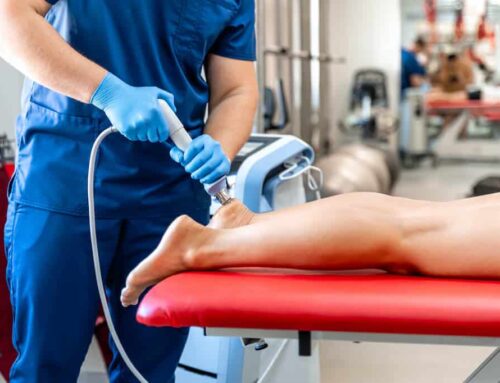What does massage do? How often should I use this lacrosse ball? Should I do it before exercise? after exercise? What’s the best method? How often should I do it? And is there anything that I should be concerned with about doing it too often. Or about the way that I’m doing it that might cause damage or harm? Does foam rolling help?
Foam rolling, lacrosse balls and massage therapy can all be great tools. However, there is a fine line since they can be overused and often over prescribed. Many times people start using foam rollers, lacrosse balls, or massage therapy as a way to start to manage pain. Over time, what they find is that they have to do it more and more often. Plus, the amount of relief that they get is less and less. And their pain starts becoming unresponsive to these methods of treatment. Usually that’s when it’s indicated that there’s something underlying that’s going on that you’re actually not resolving.
If you are having to foam roll over and over, it’s helpful to understand what is happening. Then figure out exactly what the foam roller is helping you do. Why it gives you that short term pain relief. And why it’s also not the tool that’s going to solve your issue.
Here are the benefits:
Foam rolling can be really great because it increases blood flow, which naturally decreases tension in a muscle. Let’s say that you’ve got a muscle that is overworking (use the TfL for example). Which is the muscle that attaches to your IT band. (Fun fact your IT band is actually a tendon and not a muscle). If you are foam rolling it and it is excruciating, it is not going to stop being excruciating.
You should actually focus on a muscle called your TfL. Which is the contractile part of the IT band up at the top of your hip. It compensates for a lot of the deeper hip musculature. We see it affecting cyclists, runners, a lot of people with hip pain, knee pain, and back pain of compensation in this muscle. Let’s say that your TfL, as with most people, is overcompensating for inactive muscles in the hip and or spine.
What’s going to happen when you start to use a foam roller in that area?
It’s going to start to relax the muscle, if you do it appropriately. If we think about a tight muscle, for example, we’re going to have a muscle that’s constricted. Imagine you’re making a fist. Now, what we know about blood flow in a constricted muscle is that blood flow gets less. If you imagine the veins (these are the blue things in your arm), those are actually collapsible veins that don’t really have a strong or thick wall. If you’ve got a lot of little venules, they’re called the little tiny veins in a muscle.
That muscle is contracted or it’s making a fist, that decreases the ability of blood to flow through your veins. So as a result, new blood can’t get in new blood is what brings oxygen to the tissues. Oxygen is what feeds the creation of this thing called ATP. Which is a fuel for your muscles for energy. What happens is that ATP causes the muscle to relax, it causes these things called your actin and myosin heads to release and no longer be contracted.
Therefore, if you have a contracted muscle, the veins can’t get old blood out, new blood can’t come in, which means there’s no oxygen. Meaning there’s no ATP, so that muscle stays in a contracted state and there is no blood flow. You can start to see how we start to get into this little circular pattern here where it’s kind of self perpetuating.
This can also give you insights as to why when you first start doing cupping, you get a lot of really dark pigmented blood and spots wherever you’re getting the cupping done. That’s because you’re getting a lot of old blood out. As you repeat cupping over and over you might notice that those spots get less and less dark. This is because you’ve started to remove the blood that has been stuck in there.
If you find yourself similarly, with cupping, having to do that over and over, you’re actually dealing with a muscle that keeps getting chronically tight. The question becomes figuring out why that muscle gets tight. You might be able to find some insights to that answer on our other podcasts on why muscles get tight.
Why foam rolling works:
When done correctly, foam rolling can increase blood flow. Which decreases muscular tension. Now, if these muscles are restricting your range of motion, let’s say the range of motion that you’re able to actually train in. It will result in you actually being able to have a greater range of motion through which you can train. For example, the TfL and other hip flexors would cause a hinge in your hips and limit you from actually being able to use your glutes fully to activate them through hip extension motion.
If you’re a runner, you’re not going to be propelling yourself as much. If you’re a weightlifter, you’re not going to be able to activate your glutes as strongly to get up out of the bottom of a squat. So working on the muscles that are preventing those motions prior to doing those exercises, can increase your functional range of motion. While you have that increased range of motion, you’re allowing those other muscles to actually get stronger. Which increases the chance that you’re going to be able to sustain those changes.
How often should you foam roll?
Now, a lot of the time something like TfL tightness can cause increased pain. So foam rolling can cause a reduction of pain in a muscle. If you’re having muscular pain by increasing that blood flow, which does help feed the nerves and decrease pain. Foam rolling is also great for soft tissue work.
Let’s say that you’re feeling absolutely great, you foam roll a couple times a week. One day you notice that as you’re going over the quads that your right quad is suddenly feeling a lot more tender than the left one this can start to clue you into Are you shifting your weight during your squats or during your functional movements? Are you overloading one leg versus the other? As you start to kind of use the foam roller more regularly, it can actually provide diagnostic information long before you ever have pain.
Using some sort of massage or foam roller at least once or twice a month, up to a couple times a week. Especially when they’re feeling good, because you will start to notice much earlier than the pain point that you’re having these differences side to side and how these muscles feel. Now, if you don’t foam roll, you’re never gonna feel that tightness until one day. That tightness causes some sort of other pain. If it’s your quads, it could cause some patellofemoral pain or pain underneath your kneecap. It can cause some anterior hip pain or groin pinching. Those are the types of things that you would start to notice. That comes well after you will have already been able to detect it with a foam roller.
So the next question, when should we do it?
Should we do it before exercise? Should we do it after exercise? The answer is that there’s benefits to both. Doing it before exercise can improve your range of motion so that when you are exercising, you’re actually using your full range of motion. Which helps with building better neural pathways. Which helps with building better strength and building strength into the correct patterns of movement. You can also use foam rolling after exercise in muscles that still feel a little bit stiff. But they feel like you work them during the exercise. Foam rolling afterwards can just help to keep blood flow moving through those areas and really get to any deeper levels of soft tissue restrictions that you might have.
Now the question then becomes how to do it?
A lot of people roll around on the foam roller. It should be called a foam sitter, because you should sit in the places that cause you pain. If you keep rolling over those places that are causing you pain, you’re not actually getting any of the work done. As humans, it’s natural to not want to put ourselves in a lot of pain. So it’s counterintuitive. We try to roll past the point that causes us pain as quickly as possible. We end up just rolling around on a foam roller not really getting much work done.
You want to work through a muscle. Let’s take your quads for example. You start near your kneecap and you start going up your quad at maybe about an inch per second or two. Once you find a point that starts to give you pain and tenderness you need to sit on that point. Now as you’re sitting on that point. Try not to tense tune into the rest of your body while hunching your shoulders. Shallowly start to release the tension in your body as well as in the muscle underneath the foam roller.
Working on your breathing while foam rolling will help
While you’re foam rolling, start to do some deep breathing. That’s breathing into your diaphragm, so into the abdomen and out through the mouth nice and slow using pursed lips breathing. What this has been shown to do is activate your parasympathetic nervous system. Which cues and triggers muscular relaxation at a much higher rate, and has tons of other benefits that you might get from diaphragmatic breathing anyway. But can certainly be amplified with the use of a formula.
After that pain has started to subside, you’re going to do another thing that’s counterintuitive, you’re going to start bending and unbending your knee. This is going to cause an increased amount of tenderness and or pain in that area when you first start to do it. But essentially, you end up flossing the muscle underneath the roller.
In essence, you get all the fibers above the point of pain and all the fibers below and you make sure that you are really getting the entire thing. Make sure that you get the entire muscle when you are foam rolling. Which always brings me to my next question of whether people should be using the spiked foam rollers versus the fully round foam rollers. Personally, DPT suggests fully round ones because that means you leave no ground uncovered. Versus the spiked ones, you could be missing spots just because of the natural spaces between the spikes. But an argument for the spiked ones might be that when you do hit a spot, you are using an increased amount of pressure that is more direct over that spot.
When you’re foam rolling through that pen and floss method, you should only really be working on a muscle group for about two to three minutes. You only want to do this two to three times a week, every other day at the most. You will actually have a reverse effect on your muscular system. If you try to foam roll daily or even a couple times a day, you will end up just getting tighter and tighter with the benefits lasting shorter and shorter. If you are using foam rolling to mitigate pain and you find that you have to start doing it more often. Usually that is a sign that you need to look a little bit deeper at what’s going on. Usually that’ll tell you that there’s another reason that that muscle is becoming tight, and that you need to address that.
Foam rolling should not be used only to mitigate pain
If you don’t, what’s going to end up happening is you’re going to keep mitigating that pain and reinforcing those movement patterns. Until one day you wake up with a lot more dysfunction than you had going into it. Foam rolling should not be used only to mitigate pain, there should always be another strategy of finding out what muscles that it’s actually compensating for, and strengthening those muscles such that over time.
What you actually notice is that you have to foam roll or do any soft tissue work less and less to achieve the same amount of results. Don’t get caught in the trap of thinking that more is better with foam rolling and that you just need to do something more often. What you should actually be doing is participating in some sort of program that identifies why those muscles are overactive. Then working with that program so that over time, you need to use that foam roller less and less and less and become less reliant on it. Which means that your body is actually functioning a lot more appropriately.
And then you can use the foam roller as a diagnostic tool. Where you do once or twice a week to hunt for any areas that can be indicators of increased pain. Which can tell you that an injury might be coming down the road. If you don’t do something about it soon.
Would you like to make a visit with one of our specialists?




